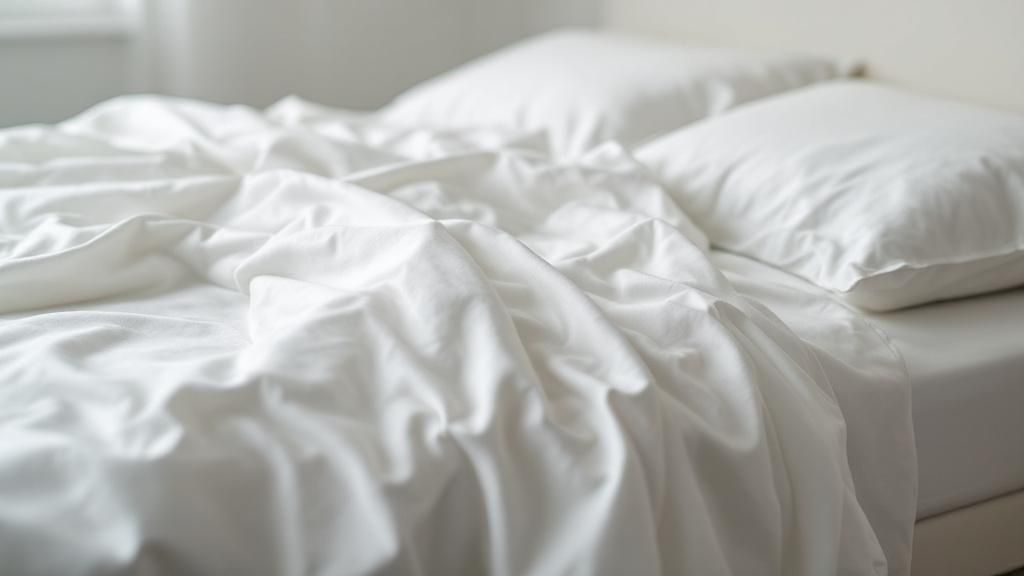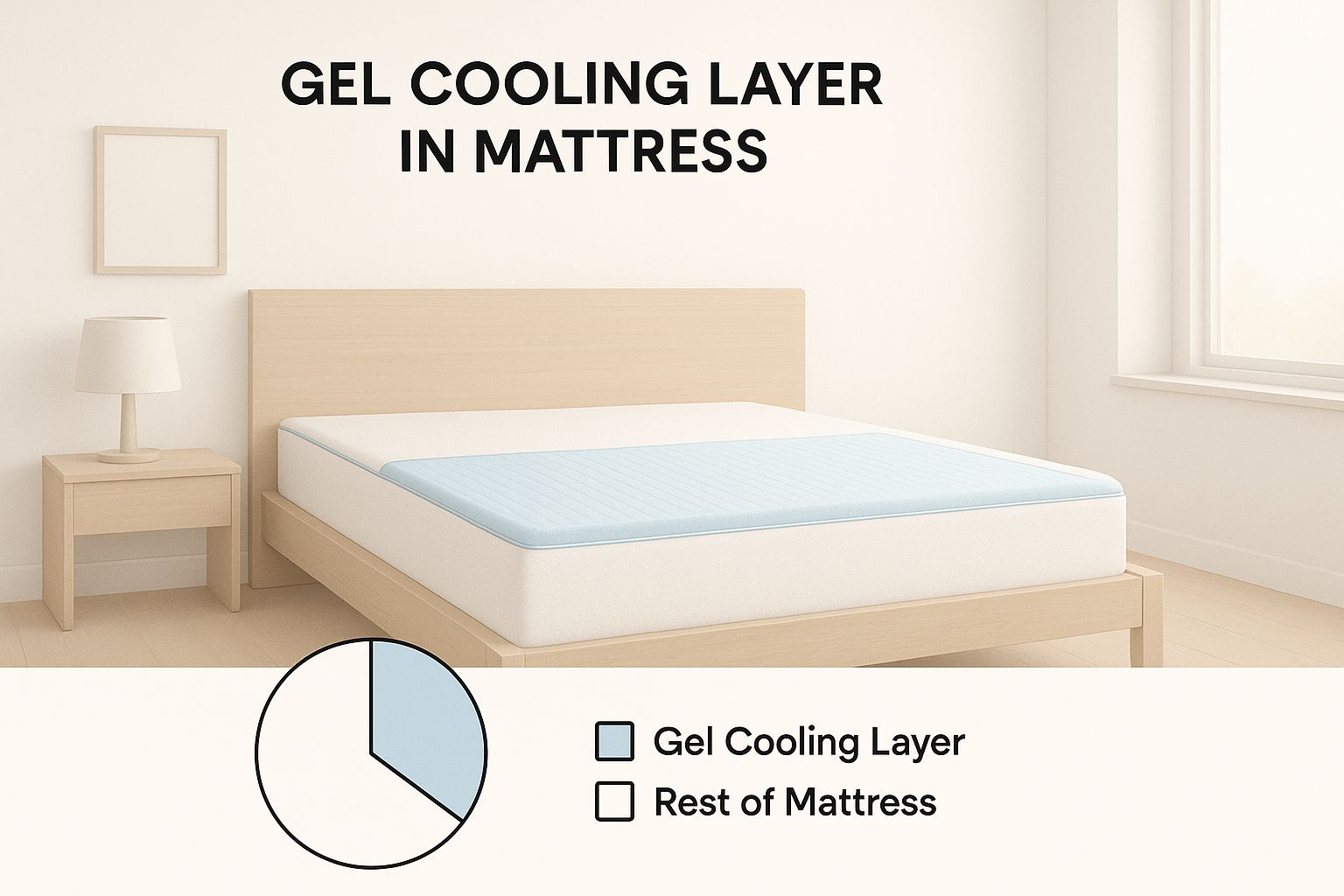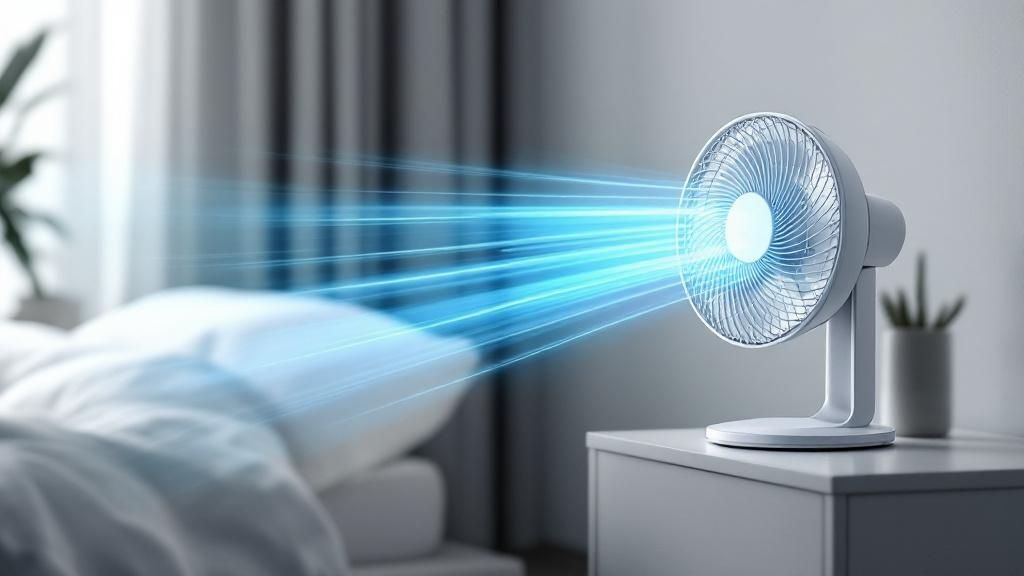Waking up in a tangled, sweaty mess isn't just a minor annoyance—it's a sign that your sleep quality is taking a serious hit. If you really want to figure out how to cool down your bed, you first have to pinpoint why it’s getting so hot in the first place. More often than not, the problem is right underneath you: your mattress and bedding are trapping body heat instead of letting it dissipate.
Why Your Bed Temperature Is Sabotaging Your Sleep
Ever gone to bed feeling perfectly comfortable, only to wake up a few hours later feeling like you’re trapped in a sauna? It’s a frustratingly common experience, and it's deeply rooted in the science of sleep.
Your body follows a natural internal clock, your circadian rhythm, which signals your core temperature to drop slightly to help you fall asleep and stay in those deep, restorative stages. When your bed creates a warm, insulated bubble around you, it's actively fighting against this crucial biological process.
A bed that holds onto heat creates a stuffy microclimate, preventing your body from cooling itself down. This constant thermal struggle leads to tossing and turning, waking up throughout the night, and feeling groggy the next day. It's not just in your head—a hot sleeping environment is a real roadblock to getting quality rest.
The Usual Suspects Behind a Hot Bed
So, what exactly is turning your cozy retreat into a heat trap? From my experience, it usually boils down to a few key culprits:
- Dense Mattresses: Traditional memory foam is a classic offender. While it feels incredibly supportive as it contours to your body, that very density is what restricts airflow. It essentially acts like a giant sponge, absorbing your body heat all night long with nowhere for it to go.
- Synthetic Bedding: Materials like polyester and microfiber might feel soft and budget-friendly, but they simply don't breathe. Unlike natural fibers that wick moisture, synthetics trap sweat and heat right next to your skin, creating a clammy, uncomfortable feeling.
- Waterproof Protectors: A non-breathable mattress protector can be the sneakiest heat-trapper of all. While fantastic for protecting your mattress from spills, many are made with a vinyl or plastic-like layer. This creates an impermeable barrier that completely blocks any heat from escaping downwards through the mattress.
This is a huge reason why dedicated bed cooling systems are no longer a niche luxury. In the U.S. alone, an estimated 50% of adults report their sleep is sometimes disrupted by being too hot or too cold. You can find more data on this growing market over at markwideresearch.com.
Once you understand these factors, you can stop fighting a losing battle. By swapping out the materials that work against you, you can start building a sleep environment that supports your body’s natural need to cool down.
Quick Ways to Cool Your Bed Down Tonight

When you're tossing and turning in the heat, desperate for relief right now, you don't need some expensive, high-tech gadget. The best ways to cool down your bed often rely on simple physics to pull heat away from your body, and they cost next to nothing.
One of the oldest tricks in the book is the "Egyptian Method." It's incredibly straightforward: take a flat sheet or even a large towel, get it damp with cool water, and then wring it out really well so it’s not dripping wet. Use this damp sheet as your blanket. As the water slowly evaporates overnight, it has a surprisingly powerful cooling effect on your skin.
Get Creative With Air and Water
Beyond the damp sheet, a little creativity with air circulation and your pre-sleep routine can make a massive difference. A well-placed fan is your best friend in a stuffy room, even without AC.
Try setting up one fan facing out of an open window to push the hot, stagnant air from your room. Then, aim a second fan across your bed. This creates a personal wind-chill effect, helping sweat evaporate from your skin much faster and cooling you down in the process.
You can also work with your body’s natural temperature cues.
I've found that taking a lukewarm shower about an hour before bed works wonders. It seems counterintuitive, but the warm water slightly raises your body temperature. Then, as you dry off and get into bed, your body temperature drops rapidly, which is a powerful signal to your brain that it's time to sleep.
For a more direct hit of cold, here's a personal favorite:
- Stick your pillowcase and even your top sheet inside a sealed plastic bag.
- Pop the bag in the freezer for about 15-30 minutes before you head to bed.
- Pulling them out, the fabric will feel incredibly crisp and cool, giving you that initial burst of relief you need to drift off.
While these tricks might not keep you icy cold all night long, they are fantastic for creating a comfortable environment to fall asleep in on those unbearable nights. They give your body the head start it needs to cool down and settle into a deeper, more restorative rest.
Choosing Bedding That Breathes
Your sheets, pillows, and even your mattress protector are what you're in direct contact with all night. They’re your first line of defense against sleeping hot. If you're serious about figuring out how to cool down your bed for good, this is the single most impactful place to start.
It all comes down to the fabric and its weave. Think about it: dense, synthetic materials like polyester are notorious heat traps. They act almost like a plastic wrap, stopping air from circulating and leaving you feeling clammy and overheated by morning.
To build a truly cool bed, you need to focus on two key things: breathability and moisture-wicking. These features are what allow air to flow freely and, just as importantly, pull sweat away from your body so it can evaporate. That evaporation is your body's natural air conditioning.
Focus on Fabrics That Perform
When you're shopping for sheets, try to look past the fancy marketing terms and get straight to the material composition. Certain natural fibers are just naturally better at keeping you cool.
- Crisp Percale Cotton: A true classic for a reason. Percale has a light, airy feel thanks to its simple one-over-one-under weave, which creates a matte finish that stays cool against the skin.
- Airy Linen: Made from flax fibers, linen is a powerhouse of breathability. Its naturally hollow fibers and looser weave create incredible airflow, making it a fantastic choice, especially in hot and humid weather.
- Silky Bamboo Viscose: This material has gained a huge following for its incredibly soft texture and superior moisture-wicking. It can absorb much more moisture than cotton, which is key to keeping your skin feeling dry and comfortable all night. If you want to dive deeper, you can learn more about how bamboo is a cool and eco-friendly choice for hot sleepers.
I always tell people to think of their bedding like performance activewear. You wouldn't go for a run in a thick wool sweater, right? The same logic applies here—you need fabrics that can handle heat and moisture while you sleep.
A cooling mattress topper can also be a game-changer, working with your sheets to pull heat away from your body, as you can see below.

This kind of specialized top layer can be a crucial part of your overall cooling strategy.
Comparing Cooling Bedding Fabrics
Choosing the right material can feel overwhelming, so I've put together this quick comparison table to help you see how the most popular options stack up.
| Fabric Type | Breathability | Moisture-Wicking | Feel | Best For |
|---|---|---|---|---|
| Percale Cotton | High | Good | Crisp & Cool | Those who love a classic, hotel-sheet feel. |
| Linen | Very High | Excellent | Textured & Airy | Hot/humid climates and sleepers who want maximum airflow. |
| Bamboo Viscose | High | Superior | Silky & Smooth | Hot sleepers who sweat and prioritize a soft feel. |
| Polyester | Low | Poor | Synthetic & Smooth | Budget-conscious shoppers who don't sleep hot. |
Each fabric has its own unique feel and performance characteristics. The best one for you really depends on your personal preferences for texture and your specific needs as a sleeper.
Look Beyond the Sheets
Great sheets are a fantastic start, but they're only one part of the puzzle. The materials inside your pillows and mattress toppers play a huge role, too. I've seen so many clients invest in good sheets only to be sabotaged by their mattress.
Traditional memory foam, for instance, is a well-known heat-retainer. It contours so closely to your body that it completely stifles airflow, trapping heat right where you don't want it.
For a cooler night's sleep from head to toe, look for fillings designed for airflow. Materials like natural latex, wool, or modern gel-infused foam alternatives are all engineered to let air circulate. They give you that wonderful pressure relief without turning your bed into an oven.
Bringing in the Big Guns: Bed Cooling Technology

So, you've upgraded your sheets and perfected your room's airflow, but you're still waking up in a sweat. When the usual fixes just don't cut it, it might be time to look at more powerful solutions. This is where technology steps in, offering systems that actively control your bed's temperature rather than just passively wicking away heat.
Make no mistake, this is an investment. But for those of us who chronically sleep hot, it can be the final piece of the puzzle for truly restful nights.
These high-tech options generally fall into two camps. You have advanced passive cooling products—think high-tech mattress toppers with gel grids or special phase-change materials woven in. They are a big step up from standard foam, designed to pull heat away from your body more efficiently.
Then you have the true game-changers: active cooling systems. These remarkable devices use either water or air to quite literally set the temperature of your sleep surface.
Active Cooling Pads and Smart Beds
Imagine setting your bed's temperature to a precise degree, just like your home’s thermostat. That’s the magic of active cooling systems.
Hydro-powered pads are one of the most popular choices. These systems feature a thin mat filled with tiny tubes that you place on your mattress. The mat connects to a small bedside control unit that chills water and circulates it through the pad, actively drawing heat away from your body all night long.
One of the best features is that many models have dual-zone controls. This is an absolute relationship-saver for couples. One person can dial their side down to a cool 65°F (18°C) while the other stays perfectly comfortable at a warmer temperature.
The demand for these systems is surging. Valued at roughly USD 1.5 billion this year, the global bed cooling system market is expected to more than double by 2033. You can explore the full analysis in the bed cooling system market report from Verified Market Reports.
At the very top end, you'll find premium smart beds with climate control built right into the mattress. These systems use gentle air circulation to keep you at your ideal temperature. While it’s a significant purchase, it represents the absolute pinnacle of personalized sleep comfort.
For the best results, pair this tech with the right fabrics. Our guide to cooling bed sheets can help you find breathable materials that work in tandem with your system. The active cooling handles the core temperature, while the sheets ensure your skin stays dry and comfortable.
Making Your Bedroom a Cool Sanctuary
Let's be honest: trying to cool just your bed when the rest of the room feels like a sauna is a fight you're destined to lose. The real secret to a cool night's sleep is thinking bigger. Your entire bedroom is a system, and managing its climate is what sets you up for success.
A great place to start is by managing sunlight, which is a major source of unwanted heat. Think of your windows as gateways for the sun's rays. Throughout the day, especially on the side of your house that gets the most sun, it’s a good idea to keep the blinds and curtains shut.
For this, blackout curtains are a game-changer. They aren't just for blocking light; their thermal lining is specifically designed to stop solar heat in its tracks. Making this a daily habit can noticeably drop your room's temperature by the time you're ready for bed.
For an even more powerful solution, you could look into exterior window sun screens. They essentially act like a pair of sunglasses for your windows, blocking a massive amount of heat before it even has a chance to get inside.
Perfecting Your Room's Temperature and Airflow
Once the sun is down, it's time to shift your focus indoors. Sleep experts generally agree that the sweet spot for your thermostat is right around 65°F (18°C). This isn't just a random number—a cooler room helps your body's core temperature drop naturally, which is a key signal that it's time to sleep.
If you're dealing with humidity, you know that sticky air can feel much warmer than the thermostat suggests. Running a dehumidifier for an hour or two before you head to bed can pull that moisture out of the air, making the room feel refreshingly crisp and cool.
Here's a pro tip that costs absolutely nothing: check your furniture placement. If your bed is pushed up against an air vent or blocking the natural path from a window to a fan, you’re sabotaging your own efforts. A clear path for air to move around is essential for cooling the whole space.
Getting your room's environment right is half the battle. If you want to dive deeper, our guide on how to keep your bedroom cool at night has even more ideas. When you combine a cool room with the right bedding, you’re creating the perfect setup for uninterrupted, restorative sleep.
Common Questions About Staying Cool in Bed
Even after trying everything, you might still have a few lingering questions about how to get your bed truly cool. Let's tackle some of the most common ones I hear from people struggling with overheating at night.
Do Cooling Gel Products Really Work?
Yes, they do, but it’s crucial to understand their limitations. Cooling gel in pillows, mattresses, or toppers uses something called conductive cooling. Think of it like this: the gel actively pulls heat away from your body, giving you that instant, refreshing "ahh" feeling when you first get into bed.
The catch is that this effect isn't permanent. Once the gel has absorbed as much heat as it can and matches your body temperature, that initial cooling sensation fades. It's fantastic for helping you fall asleep, but it's not an all-night fix on its own. To get the most out of a gel product, you absolutely need to pair it with breathable bedding to help that stored heat escape.
Is a Fan or Air Conditioning Better for Sleep?
This really boils down to your climate and your wallet. There's no contest—an air conditioner is the king of cooling. It's the only thing that actually lowers the ambient temperature of your room by pulling heat and humidity out of the air. If you live somewhere with brutal summer heat, it’s a must-have.
A fan, on the other hand, is much more energy-efficient and creates a different kind of cool. It doesn't drop the room's temperature at all. Instead, it creates a wind-chill effect on your skin, helping sweat evaporate more quickly. Since sweat is your body's natural AC, this is a very effective way to feel cooler. For many, a good ceiling fan is the perfect sweet spot.
My personal pro-tip? Use both. On those unbearably hot nights, run the AC for an hour before bed to cool the room down. Then, turn it off and switch to a fan for gentle air circulation through the night. You stay comfortable without waking up to a shocking electricity bill.
Can My Diet Affect How Hot I Sleep?
Absolutely. What you eat and drink in the hours before bed can have a huge impact on your body's internal furnace. A big, heavy meal forces your digestive system into overdrive, a process that naturally generates a surprising amount of metabolic heat.
Spicy foods and alcohol are two other big offenders. They can mess with your body's temperature regulation, often leading to night sweats. Making a simple change to a lighter evening meal and focusing on staying hydrated with plain water can make a noticeable difference in how hot you feel once you're under the covers.
Ready to finally stop fighting with your bedding? The 100% organic bamboo sheets from Bamtek are naturally breathable and moisture-wicking, creating the perfect foundation for a cool and comfortable night's sleep. Experience the cool, silky difference for yourself at bamtekhome.com.










